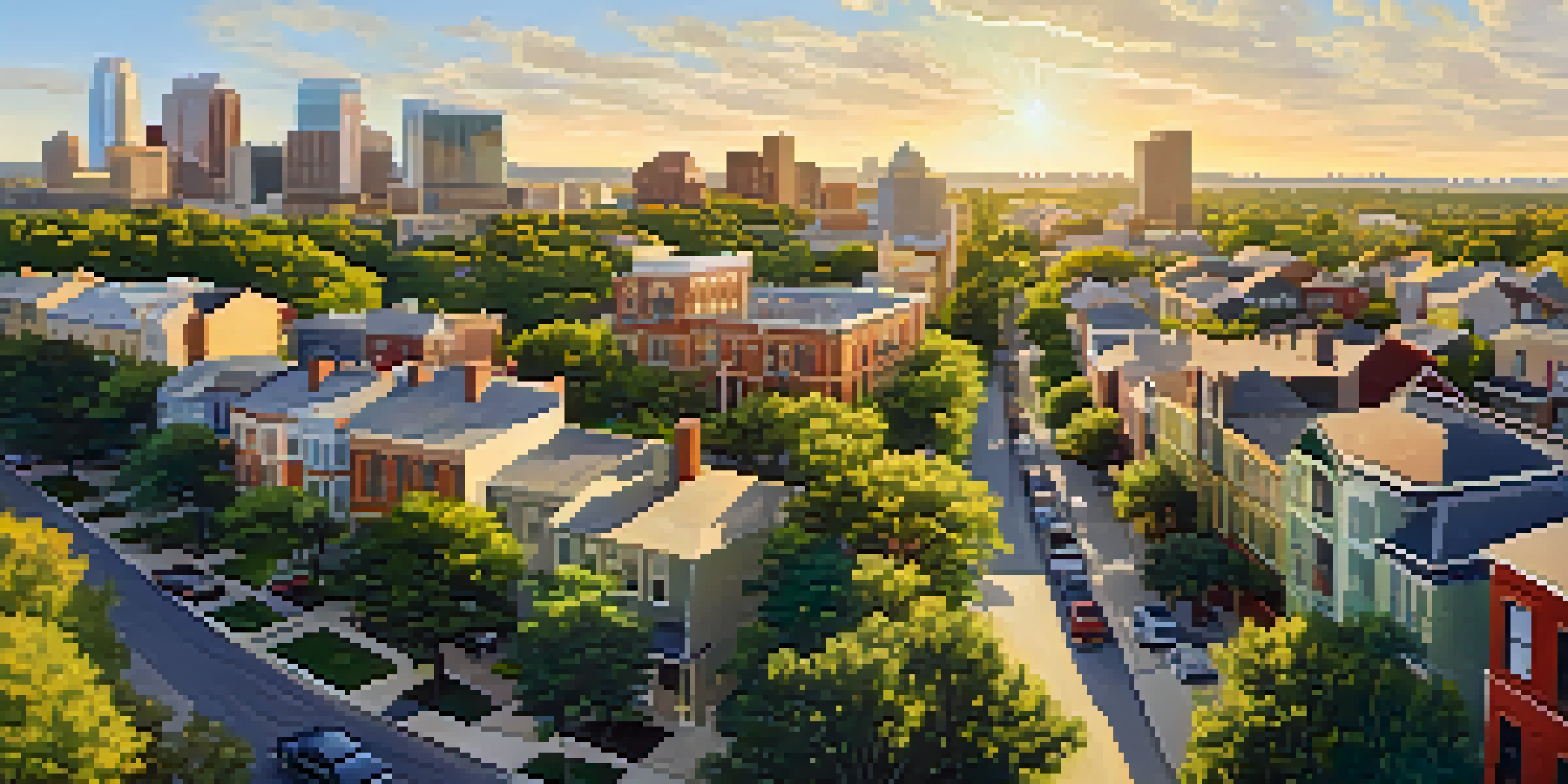Understanding the Role of Zoning Laws in Austin's Growth

What Are Zoning Laws and Their Purpose?
Zoning laws are regulations that dictate how land can be used in a community. They help organize urban development by designating specific areas for residential, commercial, and industrial purposes. This structure ensures that neighborhoods remain functional and attractive while preventing conflicts between different land uses.
Zoning is a tool of urban planning that allows communities to manage growth and development in a structured manner.
For instance, if a quiet residential area were suddenly surrounded by factories, the quality of life for residents would likely diminish. Zoning laws mitigate such scenarios by keeping incompatible uses apart. Essentially, they serve as a blueprint for how a city grows and evolves over time.
In Austin, these laws also reflect the city’s values, such as promoting sustainability and preserving green spaces. As the city continues to attract new residents and businesses, understanding these regulations becomes crucial for anyone looking to navigate the local landscape.
Historical Context: Zoning in Austin
Austin's zoning laws have evolved significantly since the early 20th century. The city's first zoning ordinance was adopted in 1928, aiming to control urban sprawl and protect property values. Over the decades, these regulations have been updated to address changing needs and population growth, reflecting the city's dynamic character.

The post-World War II boom saw a rapid increase in development, prompting the need for more comprehensive zoning regulations. As Austin grew into a tech hub, the city faced challenges like increased traffic and housing shortages, leading to calls for more flexible zoning solutions that accommodate growth while preserving community integrity.
Zoning Laws Shape Community Use
Zoning laws regulate land use in Austin, designating areas for residential, commercial, and industrial purposes to maintain community functionality and appeal.
Today, understanding the historical context of these laws provides insight into current debates surrounding affordable housing and urban density. It highlights the balancing act city planners must perform to foster growth while maintaining the unique culture that makes Austin special.
Types of Zoning in Austin
In Austin, zoning classifications range from single-family residential to mixed-use developments. Each type serves a specific purpose and helps achieve the city's planning goals. For instance, single-family zones prioritize neighborhoods with detached homes, while mixed-use zones allow for a blend of residential, commercial, and recreational spaces.
Good zoning laws can create a balance between preservation and development, leading to a vibrant community.
This variety of zoning types can significantly impact community engagement and local economies. For example, mixed-use developments can create vibrant neighborhoods where residents live, work, and play, reducing the need for long commutes and fostering a sense of community.
However, these classifications can also lead to conflicts among residents. Some may oppose higher-density developments near their homes, fearing they could change the neighborhood’s character. This ongoing dialogue is essential for maintaining a balance between growth and community values.
The Impact of Zoning on Housing Affordability
One of the most pressing issues in Austin today is housing affordability, and zoning laws play a significant role in this challenge. Strict zoning regulations can limit the types and number of housing units built, contributing to rising prices and a lack of affordable options. For instance, single-family zoning can restrict the construction of duplexes or apartments where they might otherwise fit well.
In response, there’s a growing movement advocating for more flexible zoning policies. These changes could allow for higher-density housing, such as townhomes and apartment buildings, in areas currently zoned for single-family homes. Such initiatives aim to increase the housing supply, helping to alleviate the pressure on the market.
Housing Affordability Challenges
Strict zoning regulations in Austin contribute to housing affordability issues by limiting the types and number of housing units built.
Ultimately, a thoughtful approach to zoning can create a balance between preserving neighborhood character and addressing the urgent need for affordable housing. By reexamining existing regulations, Austin can work toward a more inclusive and diverse community.
Zoning Variances and Their Significance
A zoning variance allows property owners to request exemptions from specific zoning regulations. This process can be crucial for developers looking to build projects that might not strictly comply with existing laws. For example, if a developer wants to construct a taller building than what’s permitted, they can apply for a variance to seek approval.
These variances are essential in a growing city like Austin, where unique circumstances often arise. They provide flexibility within the framework of zoning laws, allowing for innovative solutions to meet the city's evolving needs. However, granting variances can also lead to community pushback, especially if residents feel their interests are being overlooked.
Navigating the variance process often requires a delicate balance between development goals and community concerns. Engaging with local stakeholders during this process can help ensure that growth is both responsible and aligned with the values of Austin’s residents.
Zoning and Environmental Considerations
Zoning laws are not just about land use; they also play a crucial role in environmental protection. In Austin, regulations often include provisions for preserving green spaces, promoting sustainable building practices, and protecting natural resources. This focus on environmental stewardship reflects the city’s commitment to sustainability amid rapid growth.
For example, zoning can help protect critical habitats by restricting development in sensitive ecological areas. Similarly, regulations may encourage the use of permeable surfaces to reduce stormwater runoff, contributing to healthier waterways. These measures ensure that as the city expands, it does so in a way that respects and preserves its unique environment.
Future Trends in Zoning Practices
Austin's zoning laws are evolving to incorporate more flexible and inclusive practices, such as accessory dwelling units, to better meet community needs.
As more residents recognize the importance of sustainability, zoning laws can evolve to incorporate innovative practices that further enhance Austin’s green initiatives. This ongoing dialogue between development and conservation is vital to shaping a resilient future for the city.
Future Trends in Austin's Zoning Laws
As Austin continues to grow, its zoning laws will likely adapt to meet new challenges and opportunities. The city is already exploring more inclusive zoning practices, such as allowing accessory dwelling units (ADUs) to increase housing options without drastically altering neighborhood dynamics. This trend reflects a broader movement toward more flexible, community-oriented development.
Additionally, technology will play a role in shaping future zoning practices. Cities across the globe are leveraging data to make more informed zoning decisions, ensuring they meet the needs of residents while promoting sustainable growth. Austin could benefit from such innovations, enhancing community engagement and transparency in the zoning process.

Ultimately, the future of zoning in Austin hinges on collaboration among city planners, residents, and stakeholders. By embracing change and prioritizing inclusivity, the city can continue to thrive while preserving its unique character and sense of community.